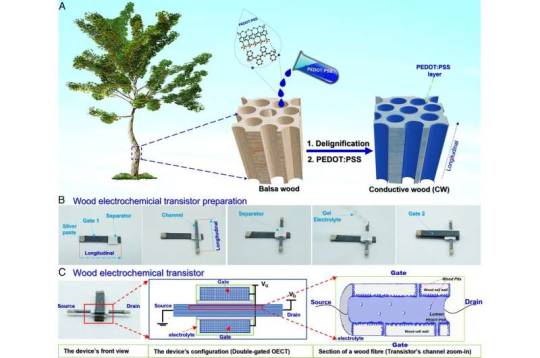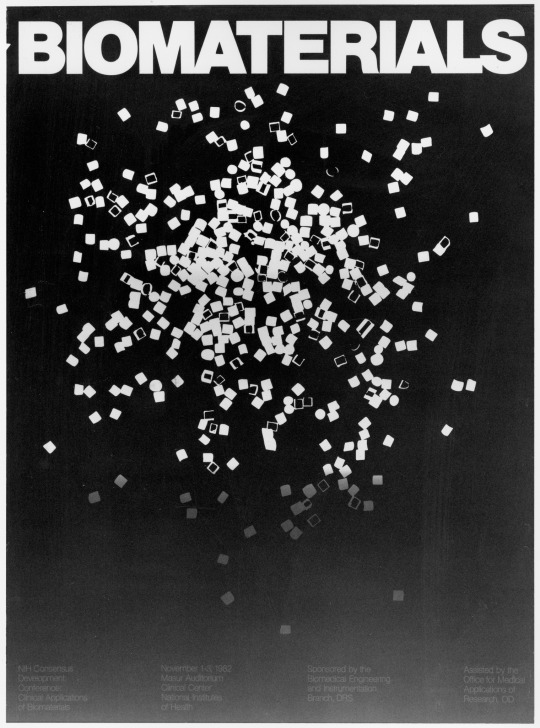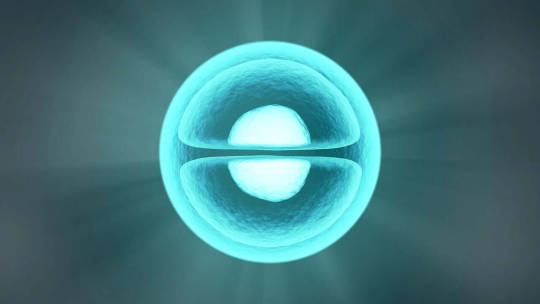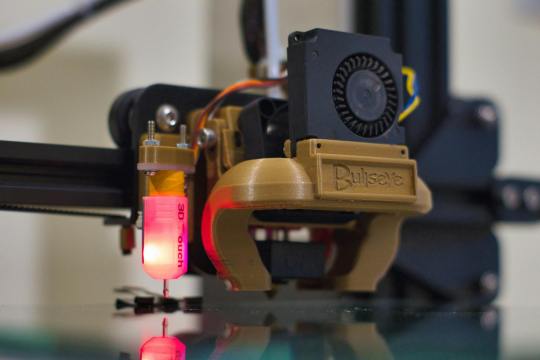#Biomaterials
Photo

Building a transistor out of treated wood
A team of organic chemists and engineers from Linköping University and KTH Royal Institute of Technology, both in Sweden, has demonstrated that working transistors can be made from treated wood. The results have been published in Proceedings of the National Academy of Sciences.
Transistors are devices that switch or amplify electrical signals in a larger device. Scientists have, over the years, learned to make them ever smaller—currently, billons of them can fit on a single computer chip. Most transistors are limited to use in certain materials—those on a chip, for example, exist on a base of the semiconducting material, silicon. In this new effort, the team in Sweden looked into the possibility of creating transistors that could be used in bioelectronic products, or even purely plant-based devices. To test the possibility, they created a transistor out of wood and a few other materials.
The team tested a variety of tree types and found that balsa seemed to suit their needs best due to its strength, permeability and low density. They started by bathing small strips of the wood in a chemical bath to remove some of its lignin, making it more porous. Then they forced a conductive type of plastic called PEDOT:PSS into the small vessels of the wood normally used for water transport, which coated the vessel walls.
Read more.
865 notes
·
View notes
Text

BIOMATERIALS POSTER [c. 1982-89]
44 notes
·
View notes
Text
Using mycelium to create a self-healing wearable leather-like material
A pair of biotechnologists at Newcastle University, working with a colleague from Northumbria University, all in the U.K., have developed a way to use mycelium to create a self-healing wearable material. In their paper published in the journal Advanced Functional Materials, Elise Elsacker, Martyn Dade-Robertson and Meng Zhang, describe their process and how well it worked when tested. Mycelium is…

View On WordPress
58 notes
·
View notes
Text
Those novel artificial nerve cells are similar to biological ones

- By InnoNurse Staff -
Linköping University (LiU) researchers in Sweden have developed an artificial organic neuron that closely resembles the properties of genuine nerve cells. Such has the ability to activate natural nerves, making it an appealing technique for future medical treatments.
Read more at Linköping University
50 notes
·
View notes
Photo

Web Site
Spider silk is renowned for its strength, but there are thousands of species of spider. Now researchers are investigating the diversity of silks from spiders around the world, such as the salty ant spider (Myrmarachne formicaria) found jumping around Japan (top, second from left) or Hasselt's spiny spider (Macracantha hasselti) found in India (middle, second from left). So far, the team have sequenced genetic information from over 1000 species, and studied the biomechanical properties of silk from over 400 of these. Drawing links between these data – between genes and traits, genotypes and phenotypes – the team find genetic clues to making different types of silk protein or spidroin. But charting the evolution of the toughest silks is only one ambition of the silkome project – researchers want to use their data to guide the design of new 'renewable, biodegradable, and sustainable' biomaterials, perhaps for use in medical procedures or biomedical engineering.
Written by John Ankers
Image from work by Kazuharu Arakawa and Nobuaki Kono, and colleagues, from the Spider Silkome Database
Institute for Advanced Biosciences, Keio University, Tsuruoka, Yamagata; Biomacromolecules Research Team, RIKEN Center for Sustainable Resource Science, Wako, Saitama, Japan and others
Image originally published with a Creative Commons Attribution 4.0 International (CC BY 4.0)
Research published in Science Advances, October 2022
You can also follow BPoD on Instagram, Twitter and Facebook
#science#biomedicine#arachnophilia#arachnophobia#spiders#spider silk#spider webs#silkome#genes#biomaterials#Halloween
14 notes
·
View notes
Text
SUSTITUTOS DEL PLASTICO
los nuevos biomateriales: algas, bacterias, leche, hongos, moluscos, kombucha o subproductos de la industria entre otros pueden llegar a ser sustitutos del plástico y de otros componentes derivados del petróleo.

2 notes
·
View notes
Photo

my morning is good, the HPLC worked perfectly until 2pm — then the instrument errors appeared again, so i’ll let the machine rest overnight, then afternoon, i processed my data and it was unexpectedly good 🥰 i also learned the conditions on when not to use the y-intercept in the calibration curve (i found a reliable source)… hence, my data i think is ready for the article our german colleagues are preparing for next month’s submission, i’ll start writing my part 💙🤍❤️ tom I’ll continue with my protein experiments —- super tired today from begging to the HPLC to start working again 😜 hence, i decided to have dinner at Leo d’Or at the centre-ville, sashimi is ❤️🍣 awesome blue sky too 💙 i look so tired in the 3rd photo haha 😂 goodnight everyone 😘 #amazingadventuresofbeaujethro #research #science #engineering #materials #biotechnology #chemistry #physics #biology #filipinoscientist #mulhouse #hplc #alsace #hautrhin #france #biomaterials (at Mulhouse, France) https://www.instagram.com/p/CpBFrxzL48f/?igshid=NGJjMDIxMWI=
#amazingadventuresofbeaujethro#research#science#engineering#materials#biotechnology#chemistry#physics#biology#filipinoscientist#mulhouse#hplc#alsace#hautrhin#france#biomaterials
3 notes
·
View notes
Video
AMINIOTIC BOTANICAL SKIN
BIOMATERIAL 2022
2 notes
·
View notes
Text

Join #Biofuels & #Bioenergy #Biodiesel2022 #Internationalconference & get YRF awards
Kindly Register Now: https://trimurl.co/k5YKT1
🗓️ Oct. 31-Nov. 01, 2022
📍 #Rome, #Italy
#biorenewable chemicals market#bioenergy news#biodiesel#biomass#biomaterials#biomanufacturing#biomanix#biomarker#bioenergoterapia częstochowa#bioenergy feedback#biogas#renewable energy#renewable sector#renewal#renewable carbon sources#renew as a crew#renewable electricity
2 notes
·
View notes
Photo

Wanna share with you a cute #mushroom I drew and some investigations into using #Mycelium as a material 🤗 #biomaterials #greeninnovations (at Earth地球) https://www.instagram.com/p/CeC2W3yvfm9/?igshid=NGJjMDIxMWI=
2 notes
·
View notes
Text
Researchers at Imperial College London have genetically engineered bacteria to grow animal- and plastic-free leather that dyes itself.
In recent years, scientists and companies have started using microbes to grow sustainable textiles or to make dyes for industry -- but this is the first time bacteria have been engineered to produce a material and its own pigment simultaneously.
Synthetic chemical dyeing is one of the most environmentally toxic processes in fashion, and black dyes -- especially those used in colouring leather -- are particularly harmful. The researchers at Imperial set out to use biology to solve this.
In tackling the problem, the researchers say their self-dyeing vegan, plastic-free leather, which has been fashioned into shoe and wallet prototypes, represents a step forward in the quest for more sustainable fashion.
Read more.
39 notes
·
View notes
Text
The U.S. biomaterials market was size reached at USD 59.34 billion in 2023 and it is expected to hit around USD 236.33 billion by 2033, poised to grow at a CAGR of 14.82% from 2024 to 2033.
0 notes
Text
How to Use Infrared Heating Pad?
Although iReviKit Infrared Mat is designed with easy operation intention, there’re several tips you should notice when using it, especially for pregnant woman and people with underlying medical conditions. Here’re the complete guide and some tips on how to use an infrared mat correctly and safely, for relaxation, pain relief, and even to gain restful sleep.
To begin, you’ll need a flat surface on which to roll out the heating pad. A place on the floor is the best choice. If you want to use the heating mat on top of your bed, a relatively firm mattress is necessary for the long-term use of the heating mat. Furthermore, if you’re planning to use an infrared mat for relaxation, it’s important to have a peaceful space where you’re not distracted in order to fully experience the mat’s relaxing benefits...
0 notes
Text
Unnatural Amino Acids: Beyond the Basics - Unlocking New Research Frontiers
Unnatural amino acids are revolutionizing research and bioengineering. Explore their applications in protein engineering, biomaterial design, and drug discovery. Discover the top players in the market and the exciting future of unnatural amino acids
The Unnatural Amino Acids Market: Pushing Boundaries in Bioengineering
The unnatural amino acids market is a rapidly evolving field with vast potential in various scientific and technological applications. Unnatural amino acids are molecules structurally similar to the 20 naturally occurring amino acids that form the building blocks of proteins. However, unnatural amino acids possess unique…

View On WordPress
#Bioengineering#Biomaterials#Bioorthogonal#Biotechnology#DrugDiscovery#FutureOfScience#NextGenMaterials#ProteinEngineering#ScientificResearch#UnnaturalAminoAcids
0 notes
Text
3D Printing: From Prototypes to Organ Transplants
In the last decade, the landscape of manufacturing, medical science, and even the arts have been fundamentally transformed by the advent of 3D printing technology. Once a niche tool used for the creation of simple prototypes, 3D printing has burgeoned into a revolutionary force that stands at the forefront of innovation across numerous sectors. This article delves into the journey of 3D printing,…

View On WordPress
#3D ink#3D models#3D printed organs#3D printing#3D scanners#Additive manufacturing#Aerospace#Artificial organs#Automotive#Bioengineering#Bioink#Biomaterials#Bioprinting#Biotechnology#CAD#Cellular structures#Ceramics#Creative tech#Custom-made#customization#Dental devices#Design#Design thinking#Development#Digital fabrication#Digital manufacturing#Digital models#Disruptive tech#Donor organs#efficiency
1 note
·
View note
Text
The boomers had asbestos, we have microplastics. But nothing will change without legal action.
#sustainability#microplastics#biomaterials#plastic#polymers#polymer science#materials science#biology
0 notes